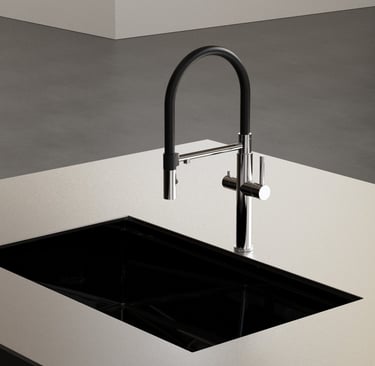The Rise of 25 mm Stainless-Steel Kitchen Faucets
Why Slimmer Engineering, Healthier Materials, and Smarter Systems Define the Next Decade of Kitchen Design
Amoanrs
10/22/20253 min read


Walk into any newly built kitchen today and you’ll notice something: the faucets are getting slimmer.
Behind that visual lightness lies a new generation of engineering — 25 mm cartridge systems crafted from 304 stainless steel.
These designs aren’t simply about appearance. They reflect a broader movement toward health-safe materials, compact logistics, and long-term durability that global developers and designers have been asking for.
At Amonars, our latest series embraces that shift — from single-handle mixers to multifunctional 3 in 1 designs — proving that precision and simplicity can live together in the same piece of metal.
1. A Smaller Core With Bigger Impact
Not long ago, the 35 mm cartridge was the standard. It worked well but forced bulkier proportions.
By contrast, the 25 mm core allows for slimmer geometry and more controlled movement.
Designers love it because it sits neatly on narrow countertops and blends into open kitchens instead of standing out awkwardly.
What’s more interesting is the side effect nobody talks about: packaging volume drops dramatically.
For exporters and contractors, that means more units per pallet, smaller carbon footprints, and fewer damaged boxes — details that rarely make it into glossy brochures but matter on every shipping invoice.
2. Stainless Steel, Not Brass — and That Matters
A large share of early 25 mm faucets used brass. Brass is easy to machine but brings two persistent problems: lead content and unstable copper pricing.
Stainless-steel bodies solve both.
They’re lead-free and food-grade safe, even for filtered-water lines.
There’s no plating layer to chip or corrode; the surface you see is the material itself.
The brushed or PVD finish ages evenly instead of fading in patches.
In short, a stainless faucet doesn’t just look cleaner — it stays that way.
And in large-scale developments, consistency across hundreds of units is what protects a brand’s reputation.
3. Beyond One Function — A Platform for Many
A 25 mm cartridge isn’t limited to one role.
Modern faucet engineering has turned it into a flexible platform:
Standard hot-and-cold mixers for compact apartments
Pull-down sprayer models for everyday residential use
3 in 1 multifunction taps combining hot, cold, and filtered water
Having all these variants share the same slender design language gives specifiers freedom to mix and match without breaking visual harmony.
It’s a quiet kind of innovation — the kind that makes every configuration feel like part of one system.
4. The Engineering You Don’t See
What makes these smaller faucets credible is what you can’t see at first glance:
precision machining and relentless testing
Each Amonars faucet goes through:
100 000 open-close cycles to ensure torque stability
Hot-and-cold shock tests to prevent thermal fatigue
Salt-spray surface tests that simulate years of humidity exposure
Even the feel of the handle — that smooth resistance between “off” and “on” — is calibrated in-house.
It’s the kind of detail designers notice subconsciously when they twist the lever.
5. Typical Use Cases
Hospitality and serviced apartments – Multi-function taps with compact boxes reduce both install time and shipping cost.
Premium residential projects – A unified aesthetic across sinks, faucets, and accessories.
OEM and system kitchens – Standardized inner design allows for private-label customization.
Urban studios – One-hole installation that keeps small countertops uncluttered.
If your project falls into any of these categories, a 25 mm stainless-steel faucet can quietly raise both design and operational efficiency.
For technical drawings or configuration advice, contact our team — we’ll match the right specification to your application.
6. How to Judge a Good 25 mm Faucet
Core Material – Solid 304 SS, not plated brass.
Valve Consistency – Smooth torque curve, no sudden friction.
Waterway Design – Clear separation if filtered water is integrated.
Surface Finish – Brushed or PVD layer resistant to scratching.
Maintenance Access – Replaceable cartridge and hoses.
Packaging Logic – Protective but compact, labeled for project use.
When all six boxes are ticked, you know the manufacturer understands more than just style.
7. Why Professionals Choose Amonars
Over two decades of manufacturing experience in kitchen and bath hardware.
A unified design language across faucets, workstation sinks, and accessories.
100 % lead-free stainless-steel construction with verified material traceability.
OEM and ODM services with flexible finishing and branding options.
Reliable export logistics covering the US, Europe, and Middle East markets.
To discuss samples, specifications, or private-label cooperation,
Contact Amonars — our engineers are ready to support your project.
8. Questions We Often Hear
Is 25 mm flow weaker than 35 mm?
No. Proper internal channels and aerators maintain full cleaning performance while reducing water waste.
Does stainless steel really outperform brass?
In corrosion resistance and hygiene, yes. Brass can oxidize and release trace metals over time; stainless steel doesn’t.
Can it be customized?
Every series can be tailored — from handle shape to surface tone — to match your regional market or brand identity.
Closing Thoughts
The evolution from 35 mm to 25 mm cartridges isn’t a marketing trick.
It’s a practical response to design minimalism, sustainability targets, and healthier living standards.
And stainless steel, with its balance of purity and strength, happens to be the perfect partner for this era.
If your next project values refinement without compromise,
talk to the team behind these faucets.
Contact Amonars to explore engineering details or partnership opportunities.
